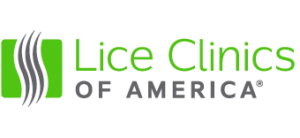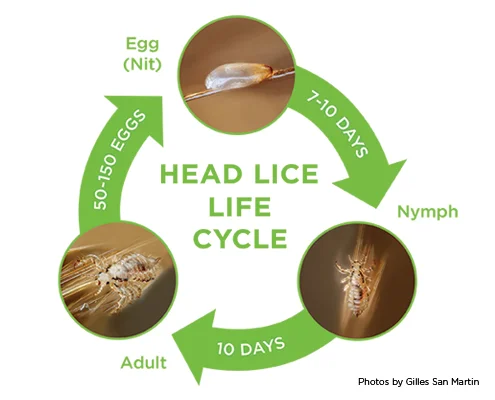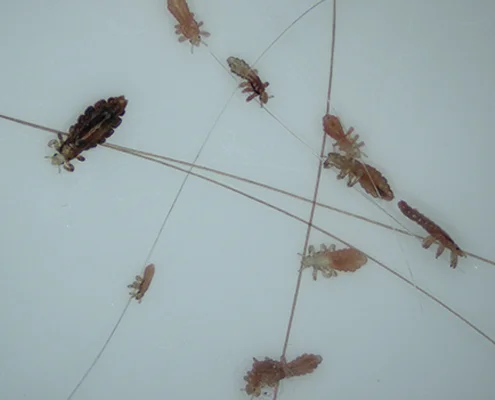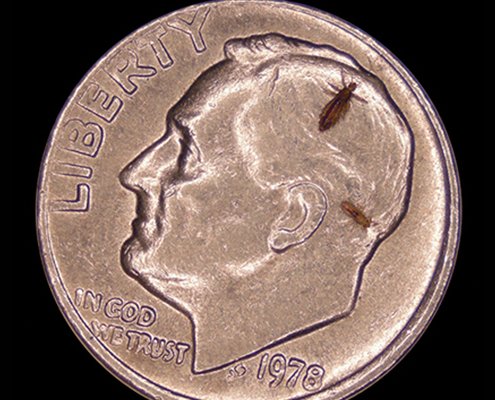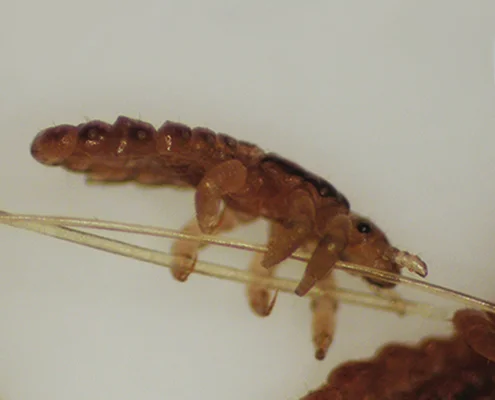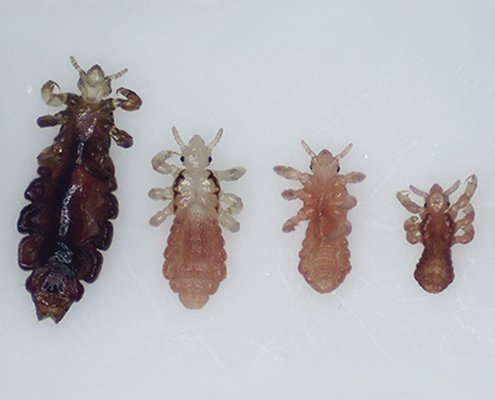WHAT IS LICE?
FACTS YOU NEED TO KNOW ABOUT LICE
Between 6 and 12 million children are infested with head lice in the US each year, according to the FDA.
Very often parents contract head lice from their children.
TYPES
There are many types of lice, the head louse, or Pediculus humanus capitis, is a parasitic insect that can be found on the head and, more rarely, the eyebrows and eyelashes of people.
LIFE CYCLE
There are three stages of the lice life cycle: egg, nymph and adult.
ANATOMY
Head lice have six claws designed for them to crawl from hair strand to hair strand. These claws allow them to move from head to head.
HEAD TO HEAD
A head-lice infestation occurs when a female adult louse moves to a new head and lays eggs. When those lice eggs hatch, the lice will most likely stay on that head throughout the entire lice life cycle. Unless the head is treated and all lice and eggs are killed, the lice infestation will continue for however long the lice can live.
LICE FACTS
FREQUENTLY ASKED QUESTIONS
How Do I Know if I Have Lice?
The tips below will help guide you in deciding if you or your child has head lice, but if you are not sure or you would feel more comfortable having a clinician take a look, schedule an appointment for Head Lice Screening at our McKinney clinic location!
Adult lice will be the easiest to spot because they are the biggest. But at the size of a sesame seed, they still aren’t that big. Although lice vary in color, if you see a grayish-white or tan bug crawling through the hair, it is probably a louse. If you look closely at an adult louse, you should be able to see human blood inside it.
Look at the hair strands about a quarter inch (~0.5 cm) off the scalp. See if you can find lice eggs (often called nits) attached to individual hairs. Nits are extremely small. They look like tiny specks and will be glued pretty securely to the hair. If you see any, try pulling them off with your fingers. If you can’t easily pull them off, they are probably eggs and not dandruff.
Do I Have to Go to a Head Lice Treatment Center to Get Rid of Lice?
No, you do not have to come in to our McKinney lice removal salon to get effective treatment. We offer a “Do It Yourself” lice removal option, our Lice Removal Kit, that includes everything you need to safely and effectively kill lice and their eggs in the privacy of your own home. This option is affordable, but does take more time to complete. Learn more!
How Do People Get Head Lice?
The primary way you can get head lice is when your head comes in direct contact with the head of an infested individual. Head-to-head contact like that doesn’t guarantee that the infestation will spread, but it gives lice the best opportunity to move from the hair of the infested person to your hair.
Head lice don’t jump, swim or fly. Without strands of hair to grab with the claws on their legs, they have trouble getting around at all. However, they can crawl pretty quickly along the hair, so if your hair comes in contact with an infested head, it doesn’t take much for a louse to hitch a ride on a strand of your hair and make its way to your scalp.
If you think you’ve been exposed to an individual with head lice, schedule an appointment with a clinician for a Head Lice Screening at our lice treatment center in McKinney.
How Long Can Lice Live?
Excluding the 8-9 days they spend as eggs, head lice can live for around 40-45 days on your head. As parasites, they feed on human blood several times a day.
If they are removed from their food source – say from getting knocked out of your hair with a brush or your hand – they can survive 24-48 hours. If they don’t find some human hair to crawl back to a new host during that time, they will die.
What’s the Easiest Way to Kill Lice?
Although there are different ways to kill lice, including suffocating them, poisoning them, starving them or drying them out, the easiest, most effective method is visiting our lice removal salon and receiving our Signature AirAllé® treatment. You will be lice and nit free after just one visit, and most times, just one hour! Learn more about this lice treatment service and schedule an appointment.
Does the AirAllé Treatment Work for Everyone?
The AirAllé® device cannot be used to treat persons who cannot sense temperature or pain; who cannot communicate physical discomfort; who have open head wounds, sores, or visible signs of skin or scalp abnormalities; who have received radiation treatment of the head within the last 6 months; who have cranial or facial implants; or who have hair that cannot be combed through with a standard comb.
The AirAllé® device is intended to kill or remove head lice and their eggs in the hair of adults and children 4 years of age and older. For children under 4, we recommend a traditional comb-out.
Does the AirAllé Treatment Really Work?
Yes! Because it is an FDA-cleared device, we can’t make up efficacy claims that aren’t backed up by clinical data.
In fact, in a 2015 clinical report on head lice by the American Academy of Pediatrics (Pediatrics volume 135, number 5, May 2015), the AirAllé® device was listed as the only device to kill lice and eggs through desiccation. Learn more about the AirAllé® device.
What Should I Do After Head Lice Treatment?
This is the number one question we get at our McKinney Lice Clinics of America lice removal salon after we treat a family for head lice, as referenced in this blog post. Luckily, head lice do not survive long if they fall off a person and cannot feed. You don’t need to spend a lot of time or money on housecleaning activities. Follow these steps to help avoid re–infestation by lice that have recently fallen off the hair or crawled onto clothing or furniture.
- Machine wash and dry clothing, bed linens, and other items that the infested person wore or used during the 2 days before treatment using the hot water (130°F) laundry cycle and the high heat drying cycle. Clothing and items that are not washable can be dry–cleaned OR sealed in a plastic bag and stored for 2 weeks.
- Soak combs and brushes in hot water (at least 130°F) for 5–10 minutes.
- Vacuum the floor and furniture, particularly where the infested person sat or lay. However, the risk of getting infested by a louse that has fallen onto a rug or carpet or furniture is very small. Head lice survive less than 1–2 days if they fall off a person and cannot feed; nits cannot hatch and usually die within a week if they are not kept at the same temperature as that found close to the human scalp. Spending much time and money on housecleaning activities is not necessary to avoid re-infestation by lice or nits that may have fallen off the head or crawled onto furniture or clothing.
- Do not use fumigant sprays; they can be toxic if inhaled or absorbed through the skin.
